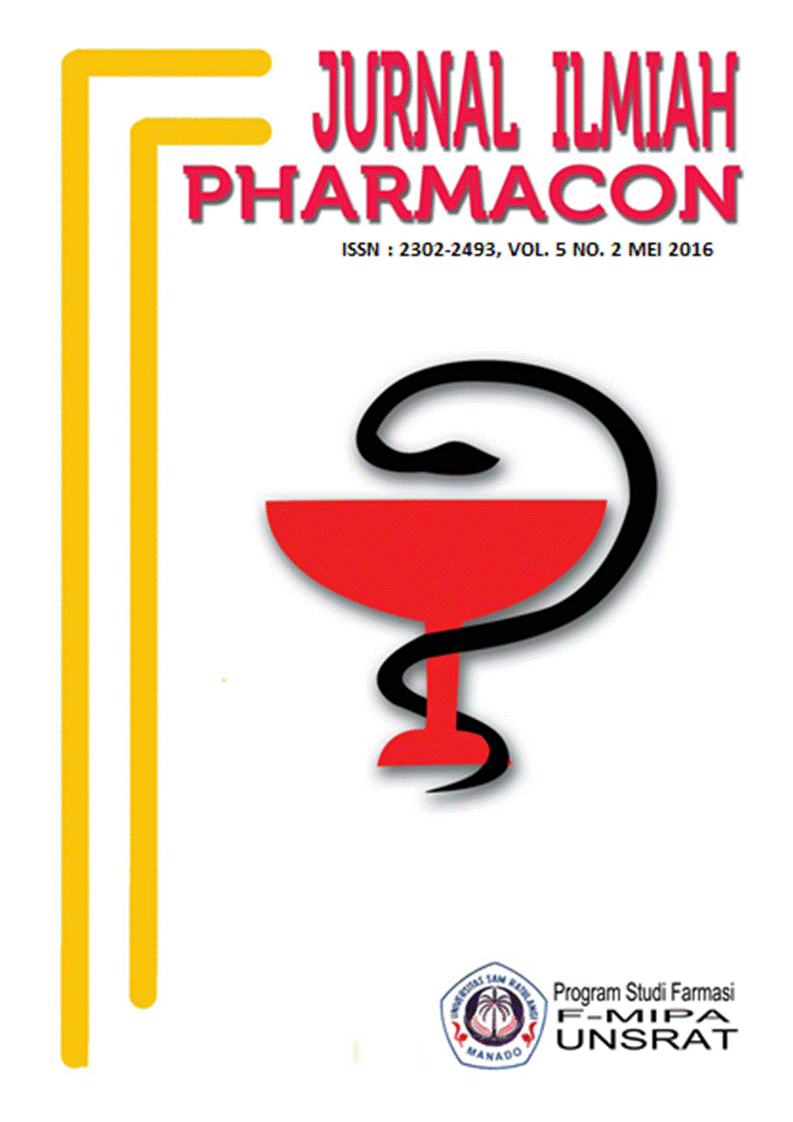ETNOBOTANI TUMBUHAN OBAT MASYARAKAT SUBETNIS TONSAWANG DI KABUPATEN MINAHASA TENGGARA PROVINSI SULAWESI UTARA
DOI:
https://doi.org/10.35799/pha.5.2016.12191Abstract
ETNOBOTANI TUMBUHAN OBAT MASYARAKAT SUBETNIS TONSAWANG DI KABUPATEN MINAHASA TENGGARA
PROVINSI SULAWESI UTARA
Â
Angela F. Mamahani1), Herny E.I. Simbala1), Saroyo1)
1)Jurusan Biologi Fakultas MIPA Universitas Sam Ratulangi, 95115
Â
ABSTRACT
Ethnobotany is a field of science that study the relationship between people (ethnic/community) and their interaction with plants (Kandowangko et al., 2011). Medicinal plants have long been used by traditional communities to treat various diseases. The knowledge of traditional medicine has been passed down from generation to generation (Ruwaidah, 2010). This study aimed to identify the species of medicinal plants that are used by Tonsawang Subethnic community and to describe their utilization. Sampling was conducted using explorative survey method. Data collection was conducted using purposive sampling method. The result showed that there are 40 species of plants from 24 families used in traditional treatment by Tonsawang Subethnic community. The medicinal plants can be eaten, drunk, or used as an external medicine. The medicinal plants are utilized in several ways: boiled; burned; pounded; taped; blended; squeezed; dropped; smeared; brewed in hot water; mixed with other traditional herbs; added salt, sugar, vinegar and coconut oil. Traditional medicinal plants are used for various needs: to treat headaches, intestinal diseases, stomachache, liver diseases, kidney diseases, gastric pain and lung diseases; as a cure for fever, malaria, intestinal parasitism, diarrhea, heartburn, swollen, dizziness, cough, cancer, body odor, itching, cataract and many kinds of external and internal injuries; to stop postpartum bleeding; to speed up recovery rate.
 Keywords : Ethnobotany, Medicinal plant, Traditional medicine, Batra, Tonsawang Subethnic
ABSTRAK
              Etnobotani merupakan suatu bidang ilmu yang mempelajari hubungan antara manusia (etnik/kelompok masyarakat) dan interaksinya dengan tumbuhan (Kandowangko et al., 2011).  Tumbuhan obat telah lama digunakan oleh masyarakat tradisional dalam penyembuhan berbagai macam penyakit. Pengetahuan pengobatan tradisional telah diwariskan secara turun-temurun dari generasi ke generasi (Ruwaidah, 2010). Penelitian ini bertujuan untuk mengidentifikasi jenis-jenis tumbuhan obat yang digunakan masyarakat subetnis tonsawang dan mendeskripsikan cara pemanfaatannya. Pengambilan sampel dilakukan dengan menggunakan metode survey exploratif. Pengambilan data dilakukan menggunakan metode purposive sampling. Hasil penelitian menunjukkan bahwa ada 40 jenis tumbuhan dari 24 famili yang digunakan dalam pengobatan tradisional oleh masyarakat Subetnis Tonsawang. Tumbuhan obat dapat dimakan, diminum atau digunakan sebagai obat luar. Tumbuhan obat dimanfaatkan dengan berbagai cara: direbus; diminum; dimakan; dibakar; ditumbuk; ditempel; diblender; diperas; ditetes; dioles; diseduh dengan air panas; dicampurkan dengan ramuan obat tradisional lainnya; ditambahkan garam, gula, cuka, dan minyak kelapa. Tumbuhan obat tradisional digunakan untuk berbagai hal, yaitu: untuk mengobati sakit kepala, usus, perut, liver, ginjal, maag dan paru-paru; sebagai obat demam, malaria, cacingan, diare, panas dalam, bengkak, meriang, batuk, kanker, bau badan, gatal-gatal, katarak, berbagai luka luar dan dalam; menghentikan pendarahan pasca melahirkan; mempercepat penyembuhan luka.Kata kunci: Etnobotani, Tumbuhan obat, Obat tradisional, Batra, Subetnis Tonsawang
Â
Â
Downloads
Published
How to Cite
Issue
Section
License
Authors who publish with this journal agree to the following terms:
- Authors retain copyright and grant the journal right of first publication with the work simultaneously licensed under a Creative Commons Attribution-NonCommercial 4.0 International License that allows others to share the work with an acknowledgement of the work's authorship and initial publication in this journal.
- Authors are permitted and encouraged to post their work online (e.g., in institutional repositories or on their website) prior to and during the submission process, as it can lead to productive exchanges, as well as earlier and greater citation of published work (See The Effect of Open Access)










